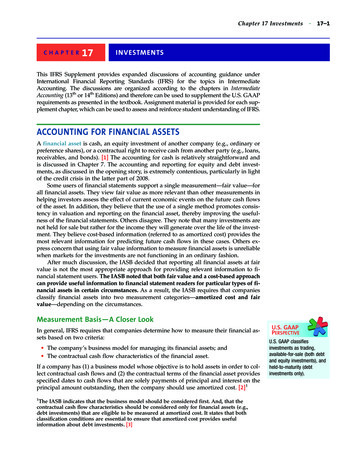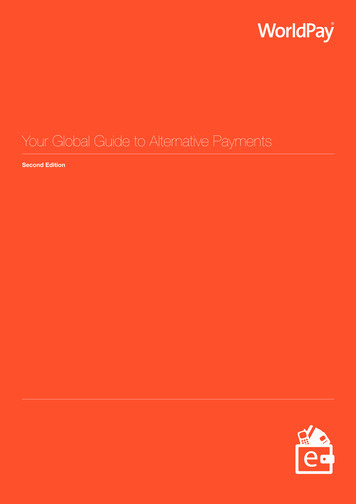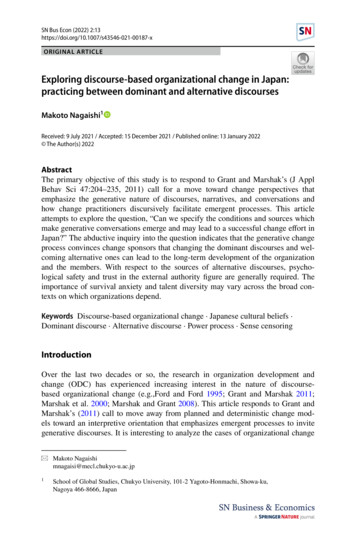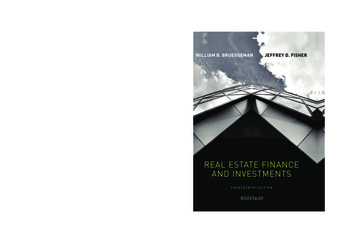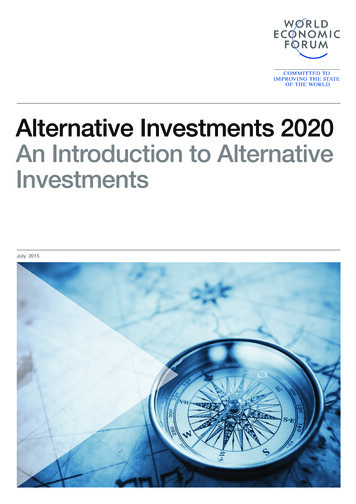
Transcription
Alternative Investments 2020An Introduction to AlternativeInvestmentsJuly 2015
World Economic Forum2015 – All rights reserved.No part of this publication may be reproduced or transmitted in any form or by any means,including photocopying and recording, or by any information storage and retrieval system.BAlternative Investments 2020: An Introduction to Alternative Investments
ContentsIntroduction and Scope2 1 Overview of alternative investments2 1.1. Definition of alternative investments2 1.2. Investment characteristics4 2 A brief history of alternative investment4 2.1. Laying the foundations foralternative investments72.2. Market events9 3 Investing in alternative investments9 3.1. Investment structure12 3.2. Investment life cycle13 4 Overview of different types ofalternative investments131415164.1. Hedge funds4.2. Private equity buyouts4.3. Venture capital4.4. Other types of alternativeinvestments18 5 Sources of capital18 5.1. Investment drivers18 5.2. Providers of capital21 6 Sources of returns22 6.1. Governance structures22 6.2. Investment selection22 6.3. Timing22 6.4. Risk management22 6.5. Leverage22 6.6. Operational improvements23 6.7. Financial engineering25 7 Role in the financial system26 7.1. Leverage27 7.2. Services27 7.3. Counterparties27 7.4. Product innovation28 8 Role in society and the economy28 8.1. Capital markets29 8.2. Real economy32333739Concluding remarks: A look to the futureGlossaryAcknowledgementsEndnotesIntroduction and ScopeAccompanying the industry’s rise have been recurring worries that hedge funds destabilize capital markets, private equity investors load firms with debt, strip their assets,then sell the firms in question, and venture capital firms invest in unicorns that maydisappear once they are in the hands of the public. While there are indeed examplesof this, short-hand indictments do not do the industry as a whole justice. A robust andeducated public debate must form the basis for how we – as a society – engage withand regulate it.Over the past three decades, the alternative investments industry has become a criticalcomponent of the global financial system and world economy. Its impact on societycan be seen across capital markets, in mainstream businesses and board rooms, andas part of the political discourse. Investors in alternatives now deploy trillions of dollarsaround the world, playing a critical role in supporting global capital markets, andredistributing risk. The industry has given rise to leading investment firms such as theBlackstone Group, Bridgewater Associates, and Sequoia Capital in the United States,CVC Capital and Brevan Howard in Europe, and The Abraaj Group and many otherfirms focused on emerging markets. It has owned or funded many well-knowncompanies across a range of industries such as Google, Facebook, Motorola, Heinz,Hertz, and Skype.The goal of this report is to provide policymakers, regulators, journalists, and the publicwith an objective overview of the industry in order to better understand the benefits andrisks associated with the industry. We believe this is to be a critically important task,given the industry’s increasingly central role in the economy and society and the oftenpolarized debate about alternatives. We have aimed, as much as possible, to explainthe industry in plain English, but some concepts pre-suppose our reader’s fundamentalunderstanding of financial markets and concepts such as liquidity. A list of useful primers on potentially puzzling terms can be found in the appendix. Our hope is that thisreport clarifies much of the mystery surrounding alternative investments, and providesreaders with a framework to evaluate facts in a comprehensive manner.The report answers some fundamental questions that surround alternative investments:——What are alternative investments?——Why do alternative investments exist and why have they grown so rapidly?——Where do alternative investors obtain their capital?——How do alternative investors generate returns?——How do alternative investors interact with the financial system?——What benefit do alternative investors provide to society?——Why is alternative investing so important for the future and what is shapingthe industry?We hope this report provides a foundation and starting point for an ongoing dialogue onthe role of alternative investments. We invite feedback and comments and look forwardto a robust debate.Alternative Investments 2020: An Introduction to Alternative Investments1
Overview of alternative investments1. Overview of alternative investments1.1 Definition of alternative investmentsIn its broadest definition, alternative investment assets are thosewhich are not part of traditional asset classes such as cash,stocks, or bonds that retail investors are most familiar with. Sucha definition would encompass investing in mainstream assetssuch as real estate or commodities or luxury goods such as artor wine. However, for this report, alternatives will be those whichhave historically utilized distinctive fund structures and which onlywealthy individuals and institutions have had access to. Alternatives will thus encompass a wide range of asset classes, includingprivate equity real estate and private equity infrastructure funds,secondary funds, and private debt funds. In particular, this reportwill focus on three asset classes: private equity buyouts, hedgefunds, and venture capital. Historically, these three have playedthe most important role in the evolution of the industry andhave accounted for the vast majority of the capital allocatedto alternatives.1.2. Investment characteristicsAlternatives offer investors a distinct set of attributes that arenot commonly found in mainstream investments such as publicstocks or government or corporate bonds. These typically includeone or more of the following attributes: long term, high risk, orilliquid investments that are associated with higher returns; lowcorrelation with traditional assets to deliver diversification benefits;inflation-hedging benefits; and scalability (the ability to absorblarge investment sums).Figure 3 shows the degree to which these and other investmentattributes are available to investors in each of the three corealternative asset classes.Figure 1 provides an overview of different types of mainstreamand alternative investments, while Figure 2 shows how alternatives fit into the broader cycle of investing savings into businessesor assets.Figure 1: Overview of different types of investmentsTraditional investmentsCashGovernment and corporate bondsPublic stocksTangible investmentsCommoditiesReal estateInfrastructureOther investmentsArtAntiquitiesWineCore alternative investmentsPrivate equity buyoutsHedge fundsVenture capitalOther alternative investmentsWidely used and accessibleto all investors (including retail)Selectively usedand only accessible towealthy individuals andinstitutional investorsSource: World Economic Forum Investors IndustriesSource: World Economic Forum Investors Industries2Alternative Investments 2020: An Introduction to Alternative InvestmentsPrivate equity infrastructurePrivate equity real estatePrivate debt fundsOther alternative funds
Overview of alternative investmentsFigure 2: The investment cycle Personal savingsRetirement plansInheritanceInvestment incomeCompany earningsTaxes .can be savedSavings. can be investedwith managers.IndividualsCompaniesNon-profitGovernments which generatesexcess cash. Start companiesAcquire companiesInvest in companiesInvest in securitiesBuild tangible assetsProvide debtUnderwrite IPOsAdvise on acquisitionsSupport trading to invest insecurities andassets. who use investment banks. in stocks, bonds,or tangible assets in alternativeinvestments. CashBank accountsMoney market fundsRetirement accountsPension fundsFoundationsAsset managersTreasuriesCompaniesGovernmentsReal estateInfrastructureNatural resourcesVenture capitalPrivate equity buyoutsHedge fundsOther (private debt,infrastructure, etc.)Source: World Economic Forum Investors IndustriesFigure 3: Expected investment attributes for core alternative investment asset classesVC Venture capital PE Private equity buyouts HF Hedge fundsImplications for:Very lowVCDescriptionTarget returns1Produces net returns to investorsRiskVariance in returns and risk of losing capitalCorrelation withother assets 2Correlation with other assets (lower is better)Inflation-linkedThe asset typically adjusts for inflationLiquidityAbility to easily sell the asset when neededScalability 3Ability to deploy large sums of capitalVery highPEHFPerformanceInvestmentattributes1 Overa 10yr horizon; Very high returns 20%, high 10-20%, moderate 5-10%, low 0-5%, very low 0%Correlation with equity markets; Very high 80-100%, high 60-79%, moderate 40-59%, low 20-39%, very low 0-19%3 The ability of an LP to deploy large amounts of capital efficiently with fund managers and/or in co-investments2Source: Cambridge Associates, Hedge Fund Research, RREEF, JPMorgan, Coller Capital, PreqinAlternative Investments 2020: An Introduction to Alternative Investments3
A brief history of alternative investment2. A brief history of alternativeinvestment2.1. Laying the foundations for alternativeinvestmentsPrivate investors, largely in the form of wealthy individuals, havedeployed capital in companies since before the Industrial Revolution. However, it was not until the mid to late 20th century thattoday’s alternative investment industry began to take shape inthe United States (Figure 4). The industry has since grown froma handful of firms in the US managing a few billion dollars to thousands of firms spread across the world that now manage morethan 7 trillion on behalf of investors. The key drivers behind thisgrowth have been regulatory changes and technological innovation in the US and global market events.2.1.1. Regulatory changesThree laws supported the birth and initial growth of the alternatives industry and two additional laws enabled the industry toscale up dramatically in the 2000s.1. US Small Business Investment Act of 1958: The law supported private investment in small businesses and innovation.It legally enabled the creation of venture capital and privateequity buyout fund structures and allowed them to use leverage. Alternative investors found the legal structures particularlyattractive, as fund profits could typically be treated and taxedat lower capital gains rates and not as income, which is usuallytaxed at higher rates.Figure 4: Key moments in the history of alternative investmentsType of EventRegulationTechnology1958: US Small Business Investment Act of 1958Enables the creation of VC and PE fund structures1972: Kenbak-1 releasedFirst personal computer heralds the computing era1973: Black–Scholes formula publishedEnabled the pricing of derivatives1978: Update to Employee Retirement Income Security Act of 1974Allows pension funds to invest in private funds192060s1970s1981: Economic Recovery Tax Act of 1981Made equity investments more attractive (vs debt)1989: Savings and loan scandal Drexel Burnham collapsedJunk bond market collapsest1999: Financial Modernization Bill (Gramm-Leach-Bliley Act)Enables the rise of large investment banks in the US1980s2008: Global financial crisisStart of a global recession2000spresent1972: Sequoia Capital foundedLeading venture capital firm1972: Kleiner Perkins Caufield & Byers foundedLeading venture capital firm1975: Bridgewater foundedLeading hedge fund1976: KKR foundedLeading private equity buyout firm1985: Blackstone foundedLeading private equity buyout firm1987: Carlyle foundedLeading private equity buyout firm1987: KKR takes over RJR NabiscoSeminal private equity buyout deal1998: Long-Term Capital implodesThreatens stability of financial system2000s: Rise of sovereign wealth fundsExpedites the rise of institutionalization2007: Blackstone IPOFirst major IPO of a PE firm2010s: New financial regulationsReshapes the financial and investment industries1 Thefirms referenced here are illustrative examples. Only space constraints prevent us from mentioning the manyother outstanding firms that played important roles throughout the history of alternative investments.Source: World Economic Forum Investors Industries4Alternative Investments 2020: An Introduction to Alternative InvestmentsFirm event11926: Graham-Newman partnership foundedFirst hedge fund1946: American Research and DevelopmentCorporationFirst venture capital fund1962: Investors Overseas Services (IOS)IOS launches first fund of funds1990s2000: Gaussian copula function publishedEnables the rise of structured products (CDO/CLO/CDS)2000: Commodity Futures Modernization Act of 2000Enables the growth of derivativesMarket event
A brief history of alternative investment2. US Department of Labor update (1978) to the EmployeeRetirement Income Security Act of 1974 (ERISA): Thisupdate lifted an earlier restriction placed on pension fundsfrom investing in privately held securities, thereby enablingthem to invest in alternative investments.Box 1: Potential impact of new financial regulations3. Economic Recovery Tax Act of 1981: The law reducedcapital gains taxes, which increased the attractiveness ofequity investments relative to debt. As a result, institutionalinvestors, such as pension funds, increased their allocationto alternative investments.4. Financial Services Modernization Bill (Gramm-Leach-BlileyAct) of 1999: The law effectively repealed the U.S. BankingAct of 1933 (Glass-Steagall Act) and enabled the creation oflarge universal banks in the US, whose activities supported thedramatic increase in the scale of private equity buyouts andhedge funds in particular.CompensationlimitsDeposit and reporting requirementsBrokerage fee limitsTrading taxProprietary trading /private equity limitsCentral Regulatory reformThus, alternative investors will likely be affected by the new regulations, even though many of the laws target banks or other actorsin the traditional financial system. Potential effects include a reduction in market liquidity, financial innovation, access to capital, andreturns to investors and an increase in costs for existing firms andbarriers to entry for new firms (Figure7).For an in-depth review of the charts below, the new regulations,and how they may shape the future of the industry, readers canrefer to a forthcoming World Economic Forum report, AlternativeInvestments 2020: Regulatory Reform and Alternative Investments.Leverage limitsFigure 5: Overview of financial reforms inthe United States and Europe by areaLegislative region5. Commodity Futures Modernization Act of 2000: This lawclarified that most types of over-the-counter derivatives, whichare not traded on exchanges, would not be subject to government oversight. The law enabled the growth of derivatives,used extensively by hedge funds, to grow unchecked by anyregulatory constraints.The future of alternative investments will likely continue to beinfluenced by regulatory changes. Following the financial crisis,regulators in the United States and Europe overhauled regulationsgoverning many highly technical aspects of the global financialsystem, with the goal of preventing a similar crisis from occurringagain (Figure 5). Regulations that target one type of financial actorcan have ramifications for many other seemingly unrelated oneswithin the financial ecosystem, given the complex set of interdependencies amongst different parts of the system (Figure 6).Dodd–Frank Wall Street Reform andConsumer Protection Act, (Dodd-Frank)§ 619 (12 U.S.C. § 1851) of the Dodd-Frank Act(Volcker Rule)Foreign Account Tax Compliance Act (FATCA)Third Basel Accord/Capital RequirementsDirective (Basel III/CRD IV)Undertakings For The Collective Investmentof Transferable Securities V (UCITS V)Alternative Investment Fund Managers Directive (AIFMD)Solvency II Directive (Solvency II)Markets in Financial Instruments Directive II (MIFID II)European Market Infrastructure Regulation (EMIR)Financial Transaction Tax (FTT)Packaged Retail Investment Products (PRIPS)International Financial Reporting Standards (IFRS)Retail Distribution Review (RDR)Source: World Economic Forum Investors IndustriesAreas affectedAlternative Investments 2020: An Introduction to Alternative Investments5
A brief history of alternative investmentVenture capitalPrivate equityHedge fundsHigh-net worth / Retail investorsPension fundsInsurance companiesAsset managersBanksRegulatory reformLegislative regionFigure 6: Implications of regulatory changes for different actorsDodd–Frank Wall Street Reform andConsumer Protection Act, (Dodd-Frank)§ 619 (12 U.S.C. § 1851) of the Dodd-Frank Act(Volcker Rule)Foreign Account Tax Compliance Act (FATCA)Third Basel Accord/Capital RequirementsDirective (Basel III/CRD IV)Undertakings For The Collective Investmentof Transferable Securities V (UCITS V)Alternative Investment Fund Managers Directive (AIFMD)Solvency II Directive (Solvency II)Markets in Financial Instruments Directive II (MIFID II)European Market Infrastructure Regulation (EMIR)Financial Transaction Tax (FTT)Packaged Retail Investment Products (PRIPS)International Financial Reporting Standards (IFRS)Retail Distribution Review (RDR)Source: World Economic Forum Investors Industries6Alternative Investments 2020: An Introduction to Alternative InvestmentsPrimary targetAlso affected
A brief history of alternative investmentFigure 7: Impact of new financial regulations on alternative investment actorsLowImplications for:CapitalmarketsInvestmentandretirementneedsHigh potential impactVCDescriptionMarket liquidityThe potential for the reform process toprofoundly decrease trading volumesFinancial marketsinnovationThe potential for any limitation on innovation tofeed back into the alternative investment industryHuman talentThe number and quality of people moving fromtraditional financial firms may fall.CostNew regulations are imposing major costs on firmsConsolidation &barriers to entryCost and regulatory complexity will formnew barriers to entryInnovationThe combined effects on talent, cost andbarriers to entry may stifle innovationAccess to capitalInvestors who could benefit from alternativeinvestments may be denied accessReturns toinvestorsThe cumulative impact of these challengesis likely to be a fall in returns to investorsPEHFSource: World Economic Forum Investors Industries2.1.2. Technological change2.2. Market eventsThe technology revolution, in part funded by alternative investors(venture capital), and innovative ideas by academics also played apivotal role in the history of alternative investments. The dramaticincrease in computing power transformed financial markets andmade it possible to record, track, move, store, and analyse previously unmanageable and unthinkable amounts of data. In addition, academic innovations in the form of the Nobel Prize winningBlack-Scholes options pricing formula (1973) and the applicationof the Gaussian copula theorems to financial instruments (2000)enabled investors to quickly and easily price complex financialproducts such as derivatives1 and structured securities, whichsupported their rapid growth and increased liquidity in marketsoverall.2, 3 Hedge funds benefited immensely from these changes,as their business models often rely on the large and liquid marketsand/or accessing, analysing, and valuing large amounts of dataor complex financial instruments.Building upon the aforementioned foundations, the alternativeinvestment industry has grown with each passing decade.—— 1980s: The economic boom and growth of the high yield(junk bond) market proved critical to the growth of privateequity buyouts, as firms used the debt to acquire much largercompanies than they would have been able to otherwise.—— 1990s: Strong market returns, in large part driven by venturecapital backed companies, generated large amounts of privatewealth, which served to fuel investments in hedge funds.—— 2000s: Investments in venture capital fell significantly following the dotcom crash. However, the credit driven economicresurgence allowed private equity buyouts and hedge fundsto scale up to new heights.——2010s: Alternative investments performed well relative totraditional investments during and after the financial crisis. Theresult was an increase in demand for alternative investments,which enabled the growth of non-core alternative investments.Alternative Investments 2020: An Introduction to Alternative Investments7
A brief history of alternative investmentToday, the alternative investment industry is truly global in bothbreadth and depth. More than 10,000 firms (Figure 8) mange some 7 trillion in assets under management (Figure 9). The capital isinvested across the globe in companies at every stage of development and in every imaginable industry sector.The industry has expanded beyond the core and now includes arange of additional asset classes. Some are specific to alternatives, such as secondary funds, which seek to acquire stakes inexisting alternative funds, while others utilize private equity stylefund structures and investment techniques to target traditionalasset classes such as real estate, infrastructure, or private debt.Figure 8: Growth of core alternative asset classes4Total number of hedge funds, private equity buyout, and venture capital 19941993199219911,0001990200Venture capitalPrivate equity buyoutsHedge fundsSource: Preqin, HFRFigure 9: Growth in assets under management by asset class5Total alternative assets under management, rivate equity infrastructurePrivate equity real estateVenture capitalPrivate equity buyoutsHedge funds1,000Source: Preqin,Hedge Fund Research8Alternative Investments 2020: An Introduction to Alternative 005200420032002200120001999
Investing in alternative investments3. Investing in alternative investments3.1. Investment structureThe legal structures used by alternative investment funds differsignificantly from most traditional fund arrangements (mutualfunds in the US, unit trusts in the United Kingdom, and UCITSfunds in Europe), even though both entail a fund investing onbehalf of an investor. This results in different and unique feestructures, investment lifespans, degrees of freedom with regardto the investment mandate, cash flow patterns, liquidity andinvestor constraints, and performance metrics. Figure 10 providesan overview of the key differences between alternative investmentfunds and traditional funds, such as mutual funds.3.1.1. Investor constraintsMost governments only permit wealthy individuals and institutionalinvestors (such as pension funds, sovereign wealth funds, andendowments and foundations) to invest in alternative investments.The belief is that such investors are better able to understand andmanage the complex, often high risk, and illiquid nature of alternative investments.3.1.2. Investment lifespanMost types of alternative investments utilize closed-end fundstructures that have a fixed lifespan (typically 10-15 years). Allof the value of the investment is returned to investors within thistimeframe, who must then identify new investment opportunitiesto reinvest the capital in. Hedge funds are a noteworthy exception, as they usually offer open ended funds, which are similar instyle to traditional fund structures, in that the capital is automatically reinvested with the fund unless the investor requests thatthe capital be returned to them.3.1.3. Investment mandateThe legal structure that alternative investment funds use is quiteflexible relative to traditional funds. Alternative investors usuallyhave broad investment mandates, which allows them to employa diverse range of strategies and pursue a wide range of investments. Moreover, they are not constrained by legal barriersimposed on traditional funds that limit their ability to use debt(leverage), short sell securities, invest in illiquid securities, oruse derivatives when seeking to execute on their strategies.Figure 10: Comparison of investment attributes for alternative vs traditional fund structuresTraditional investmentsAlternative investmentsClosed-end funds Types ofinvestments Fee structuresAsset classesInvestmentlifespan1 ThereInvestment scopePrivate equity buyoutsPrivate equity real estatePrivate equity infrastructureDistressed debt Venture capitalSecondaryPrivate debtOpen-end funds Hedge fundsOpen-end funds Public stocksGovernment andcorporate bondsCash Management feesPerformance fees hurdle rate Management fees Management feesPerformance fees hurdle rate Usually 10-12 years Microseconds to 18 months Days to years Flexible investment scopeOften illiquidCan use debt and derivatives Flexible investment scopeCan be illiquidCan use debt and derivatives Narrowly defined scopeLiquid and long only securities1Limited ability to use debt Cash flowpatterns Unpredictable when cash will be investedor returned to an investor Relatively predictable whencash will be invested/returnedLiquidityconstraints No withdrawals permittedSecondary sales are permitted Investorconstraints Only wealthy individualsInstitutional investors Performancemetrics Money weighted (internal rate of return) Relatively predictable whencash will be invested/returnedStaggered withdrawals (months),with a delay Ability to withdraw all capitalin a short period (days)Only wealthy individualsInstitutional investors Any individualInstitutional investors Time weighted returnMoney weighted(internal rate of return)are some exceptions to this long only means that funds do not short securitiesSource: World Economic Forum Investors IndustriesAlternative Investments 2020: An Introduction to Alternative Investments9
Investing in alternative investments3.1.4. Cash flow patterns3.1.6. Fee structuresAlternative investments have more unpredictability in the size andtiming of cash flows than that of traditional funds. Cash investedin a traditional stock or bond fund is usually fully invested withinone business day. In contrast, most alternative investment fundsaccept cash commitments from investors, but no cash is transferred to the fund until it needs the cash to make an investment.There can be a lengthy delay (months to years) between whenthe capital is committed and when it is invested. Importantly, thefull amount of capital committed will be invested (a “capital call”)over a period of time (often years). The return of capital (a “distribution”) to an investor is equally unpredictable, since fund managers cannot predict the timing or price of an asset in advance.The resulting cash flow pattern is known as a j-curve, which isillustrated in Figure 11.Alternative investment funds have two primary fees: management fees and performance fees. Management fees are similar innature to those charged by traditional investment products, butperformance fees are unique, as traditional funds are not typicallypermitted to charge performance fees.The most important feerelated factors are:3.1.5. Liquidity constraintsAlternative investment funds are much more illiquid than traditional funds. Most use closed-end fund structures that do not permitinvestors to withdraw their capital from the fund due to the illiquidnature of the investments. However, investors can sell their staketo a secondary fund, which specializes in such transactions.In contrast, open-ended fund structures allow investors to requestthat their capital be returned to them at any time. In traditionalmutual funds, fund managers are required to return the capitalwithin a matter of days. Hedge funds often use open-endedstructures as well, but they do not have the same requirementto quickly return the capital to investors. Rather, investors mustsubmit requests 1-12 months in advance and on a staggeredbasis. The delay reflects the fact that the underlying investmentsare sometimes illiquid and cannot be sold quickly without incurring large losses.Figure 11: Illustration of cash in/outflows for closed-endfund structuresIllustration of closed-end fund cash 40-1000123456Capital calls (cash from investor to fund)Distributions (cash returned to investor)78910Cumulative (cashreturned to investor)Source: World Economic Forum Investors Industries10Alternative Investments 2020: An Introduction to Alternative Investments—— Management fee: Fund managers usually receive fees of1-2% of raised or invested capital per annum. Such fees areintended to cover the costs of operating the fund. Fees inexcess of these costs are retained by the firm that managesthe fund, which can create an incentive to raise large funds.—— Performance fees (also known as carry): Fund managerstypically receive 20% of net profits generated by the fund overits lifespan, once the hurdle rate (discussed below) has beenmet. Sharing in the profits serves to align the interests of thefund manager and the underlying investor.—— Hurdle rate (also known as a high watermark or preferredrate of return): Most fund agreements stipulate a hurdle rate of7-8%. Fund managers do not receive performance fees untilthey meet the hurdle rate. As the hurdle rate is calculated overthe whole life of a fund, sub-par returns in one year need tobe matched with outsized returns in following years. This incentivizes fund managers to aim for high absolute returns andtake a long-term view.3.1.7. Performance metricsAlternative investors use different performance metrics thanthose used by traditional funds. The difference reflects the factthat the former have control over the timing of an investment,but traditional managers do not (the investor determines this).Traditional funds measure retur
Apr 03, 2015 · private equity real estate and private equity infrastructure funds, secondary funds, and private debt funds. In particular, this report will focus on three asset classes: private equity buyouts, hedge funds, and venture capital. Historically, these three have played the
